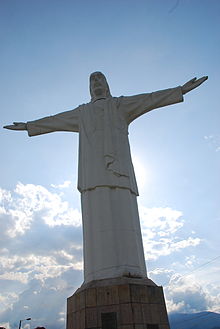
Santiago de Cali, or Cali, is the capital of the Valle del Cauca department, and the most populous city in southwest Colombia, with 2,227,642 residents according to the 2018 census. The city spans 560.3 km2 (216.3 sq mi) with 120.9 km2 (46.7 sq mi) of urban area, making Cali the second-largest city in the country by area and the third most populous after Bogota and Medellin. As the only major Colombian city with access to the Pacific Coast, Cali is the main urban and economic center in the south of the country, and has one of Colombia's fastest-growing economies. The city was founded on 25 July 1536 by the Spanish explorer Sebastian Belalcazar.

Christ the Redeemer is an Art Deco statue of Jesus Christ in Rio de Janeiro, Brazil, created by French sculptor Paul Landowski and built by Brazilian engineer Heitor da Silva Costa, in collaboration with French engineer Albert Caquot. Romanian sculptor Gheorghe Leonida sculpted the face. Constructed between 1922 and 1931, the statue is 30 metres (98 ft) high, excluding its 8-metre (26 ft) pedestal. The arms stretch 28 metres (92 ft) wide. It is made of reinforced concrete and soapstone. Christ the Redeemer differs considerably from its original design, as the initial plan was a large Christ with a globe in one hand and a cross in the other. Although the project organisers originally accepted the design, it later changed to the statue of today, with the arms spread out wide.

Silao, officially Silao de la Victoria, is a city in the west-central part of the state of Guanajuato in Mexico. It is the seat of the municipality with the same name. As of the 2005 census, the city had a population of 147,123, making it the seventh-largest community in the state. Silao is a center of agricultural and industrial activity.
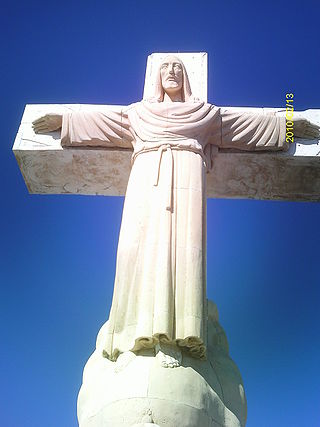
Urbici Soler (1890–1953) was an American sculptor and art educator. He is remembered chiefly for Cristo Rey, a monumental statue of Jesus on the cross atop Mount Cristo Rey in the El Paso suburb of Sunland Park, New Mexico, which he completed in 1939 and which is a site of Roman Catholic pilgrimage.

Cristo Rey is a statue on top of Cerro del Cubilete,, a 200 metres (660 ft) mountain in Silao Municipality in Guanajuato, Mexico.
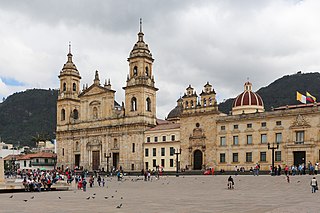
The Metropolitan and Primate Cathedral Basilica of the Immaculate Conception and Saint Peter of Bogotá or better known as the Metropolitan Cathedral Basilica of Bogotá and Primate of Colombia, officially Sacred Holy Temple Metropolitan Cathedral Basilica and Primate of the Immaculate Conception of Mary and Saint Peter, is a cathedral church of Catholic worship consecrated to the Immaculate Conception and under the patronage of Saint Peter; it is a Neoclassical style building located in the Plaza de Bolívar in Bogotá, the country's capital.

Christ the Redeemer of the Andes is a monument high in the Principal Cordillera of the Andes at 3,832 metres (12,572 ft) above mean sea level on the border between Argentina and Chile. It was unveiled on 13 March 1904 as a celebration of the peaceful resolution of the border dispute between the two countries.

Ixtlán del Río is both a municipality and municipal seat in the Mexican state of Nayarit. In 2018 the population of the municipality was 33,289 and the total area was 581.4 km².
Christ the King is a title of Jesus.

Cristo de la Concordia is a statue of Jesus Christ located atop San Pedro Hill, to the east of Cochabamba, Bolivia. It is accessible by cable car, or by climbing 2,000 steps. The statue is 34.20 metres (112.2 ft) tall, on a pedestal of 6.24 metres (20.5 ft), for a total height of 40.44 metres (132.7 ft).
Rafael Pi Belda was a Spanish sculptor. He studied beaux-arts in Valencia under the guidance of Enrique Pérez Comendador and José Ortells López. His works are mainly figurative.

The Christ of the Mercy is a colossal statue of Jesus Christ in the city of San Juan del Sur, Nicaragua, to a height of 134m above sea level . The statue is located high above the northernmost seawall in the bay of San Juan. At the foot of the statue is a small chapel. Information: Inside the chapel, the full name of the work is provided, along with text dating the construction to 2009. As of January of 2017, the entrance fee is $2 for foreigners and $1 for Nicaraguan nationals.
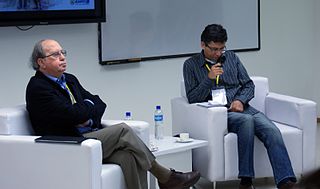
Jesús Martín-Barbero was a Spanish-Colombian communication scientist.

The Cristo del Otero is a large sculpture and symbol of the city of Palencia in Spain, located on a knoll (otero) on the outskirts of the city. Another name, much less popular, is the Monument to the Sacred Heart of Jesus. The sculpture was designed by Victorio Macho, and it is also the location of his tomb.
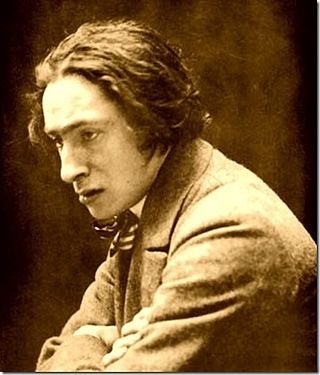
Victorio Macho was a renowned 20th century Spanish sculptor. He is considered to be one of the greats of modern Spanish sculpture. His style was influenced by art deco. His home and workshop in Toledo was converted into a museum dedicated to his work, the Victorio Macho Museum, after his death. He has been featured on a postage stamp of Spain.
The following is a timeline of the history of the city of Ocaña, Colombia.

Francisco Zenteno Bujáidar was a Mexican painter, illustrator, muralist and graphic artist. He co-founded Tepito Arte Acá, one of the first organizations of the Los Grupos movement. He also founded organizations such as the Asociación de Artistas Plásticos de México to promote Mexican art and artists.

El Gato del Río is a sculpture by Colombian artist Hernando Tejada. The sculpture was inaugurated on July 3, 1996 and is located on the side of the Cali River in Cali, Colombia. Over time, it has turned into a famous landmark of the city along with the monument to Sebastián de Belalcázar and Cristo Rey.
